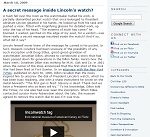As COVID-19 deaths spiked in 2020, Suzanne Firstenberg’s public art installation "In America: How could this happen…"
History Explorer Results (41)
Related Books (3)

Grade Range:
K-12
Resource Type(s):
Artifacts, Primary Sources
Date Posted:
1/22/2009
This small piece of yellow metal is believed to be the first piece of gold discovered in 1848 at Sutter's Mill in California, launching the gold rush.
John Marshall was superintending the construction of a sawmill for Col. John Sutter on the morning of January 25, 1848, on the Sout

Grade Range:
K-12
Resource Type(s):
Artifacts, Primary Sources
Date Posted:
11/6/2008
This lithograph illustrates the chaos and conflict engulfing northern Mexico during the years of the Mexican-American War from 1846-1848. In these years the United States organized an Army of Occupation, initially led by General Zachary Taylor, to capture cities like Monterrey in preparation for

Grade Range:
K-12
Resource Type(s):
Artifacts, Primary Sources
Date Posted:
10/27/2008
This spur, worn over a riding boot, was made in Mexico in the mid-1800s. Rubbed against the animal's side, spurs are one of the instruments that riders use to direct horses. The spikes on this spur are set on a small wheel called a rowel, making this a rowel spur. Horses and good riding equipment

Grade Range:
K-12
Resource Type(s):
Artifacts, Primary Sources
Date Posted:
10/9/2008
The astrolabe is an astronomical calculating device used from ancient times into the eighteenth century. Measuring the height of a star using the back of the instrument, and knowing the latitude, one could find the time of night and the position of other stars. The openwork piece on the front, ca

Grade Range:
8-12
Resource Type(s):
Reference Materials
Date Posted:
7/9/2012
In this post, students will learn about George Westinghouse, Sr. during his Civil War service, before he became a pioneer of the electrical industry. A transcript of the letter is availalbe for download. Written by Hal Wallace, Associate Curator of Electricity Collections, this post is publi

Grade Range:
8-12
Resource Type(s):
Reference Materials
Date Posted:
7/9/2012
In this post, students will learn how the Civil War impacted the development of the watch-making industry in the United States by studying one particular watch in the collection. Written by Carlene Stephens, Curator for the Division of Work and Industry, this post is published on the Mu

Grade Range:
8-12
Resource Type(s):
Reference Materials
Date Posted:
7/9/2012
In this post, students will learn about an inscription hidden inside President Abraham Lincoln's watch that was a secret until the Museum investigated further in 2009. The message was put there by watchmaker Jonathan Dillon, who was repairing Lincoln's watch when the first shots were fired on For

Grade Range:
8-12
Resource Type(s):
Reference Materials, Interactives & Media
Duration:
5 minutes
Date Posted:
7/9/2012
In this post, students will learn how photographs shaped the public’s knowledge and experience of the Civil War, and how people shaped photographs to leave a legacy of how they personally experienced and understood the war. Written by Shannon Perich, Associate Curator for the Photogra

Grade Range:
8-12
Resource Type(s):
Reference Materials
Date Posted:
7/9/2012
In this post, students will learn about Washington during the Civil War. During the war, Washington’s busy wharves were the focal point for moving people and supplies into and out of the city. Here the wounded from the Virginia battlefields were off-loaded from steamboats to await transpor

Grade Range:
8-12
Resource Type(s):
Reference Materials
Date Posted:
7/9/2012
In this post, students will explore Louisa May Alcott's service as a nurse during the Civil War. While Alcott is perhaps best known as the author of the 19th-century classic Little Women, she also served as a Union nurse in Washington, D.C. at Georgetown’s Union Hotel Hospita












